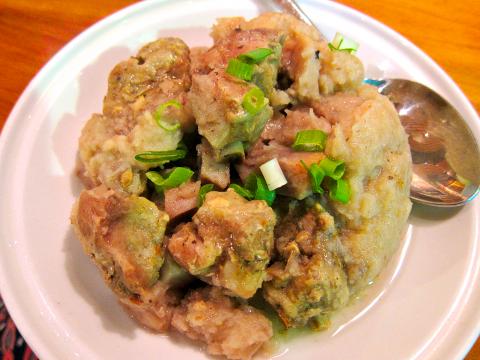The neighborhood around Yongkang Street (永康街) is packed with restaurants serving traditional Taiwanese cuisine. Fengsheng (豐盛食堂) stands out from its competitors, however, with its friendly service and simple but elegant decor, which shows off antiques collected in Miaoli County’s Sanyi Township (三義鄉).
Two back dining rooms for private parties were added last month. The centerpiece of the space is a set of antique carved wooden doors with windows that sport ingenious sliding shutters. A waitress was eager to show me the wooden mechanism at the bottom of each shutter that allows it to open or close with the flick of a finger. The main dining room, meanwhile, is decorated with two large panels made from brightly colored Taiwanese floral cloth.
Fengsheng’s menu is just as classic and thoughtful as its interior. Ingredients for its most popular dishes are shown off in a refrigerated display case and a giant picture menu on the wall highlights popular dishes, which makes ordering a snap.

Photo: Catherine Shu, Taipei Times
Pork dishes are especially good. My favorite was the hongzao braised pork (紅糟松阪肉, NT$180), which is first marinated in the bright red sediment left over from the production of Shaohsing rice wine (紹興酒). The thin slices of pork shoulder are amply veined with fat and have a very slightly chewy texture, while the hongzao marinade lends the meat a full-bodied, robust flavor.
The dried vegetable pork (菜乾肉, NT$160) is made with sprigs of dried cauliflower stewed and then served with chunks of pork. The cauliflower, firm and a bit crunchy, soaks up the rich, savory sauce and is complemented well by the tender, fatty chunks of pork.
Another pork dish, but with a completely different set of flavors and textures, is the taro root ribs (芋頭排骨, NT$160). The braised ribs, cooked until the meat slides off the bone, are nestled on top of a mound of mashed taro root. I wondered if the taro root would be too mushy to work well with the tender meat, but its soft, slightly grainy texture and sweet, mellow flavor actually provided a good contrast.
One of Fengsheng’s best-selling seafood dishes is the garlic paste oysters (蒜泥蚵, NT$160). The small, plump shellfish are lightly stir-fried and then drenched in a very pungent garlic sauce. The dish is served with a giant heap of ginger slices and at first the competing flavors — briny oysters, biting garlic and snappy ginger — were jarring. But after a few bites, they began to settle in and blend pleasingly together.
The other two seafood dishes I tried were good, but not particularly memorable. The juicy, plump meat of the steamed milkfish fillets (煎虱目魚肚, NT$180) was delicately sweet, especially when drizzled with a little bit of lime juice, while the five flavor calamari (五味中卷, NT$160) was cooked just right and tasted delicious when dipped in cocktail sauce and wasabi. Similar versions of both dishes, however, can be found in plenty of restaurants.

One of the biggest sore spots in Taiwan’s historical friendship with the US came in 1979 when US president Jimmy Carter broke off formal diplomatic relations with Taiwan’s Republic of China (ROC) government so that the US could establish relations with the People’s Republic of China (PRC). Taiwan’s derecognition came purely at China’s insistence, and the US took the deal. Retired American diplomat John Tkacik, who for almost decade surrounding that schism, from 1974 to 1982, worked in embassies in Taipei and Beijing and at the Taiwan Desk in Washington DC, recently argued in the Taipei Times that “President Carter’s derecognition

This year will go down in the history books. Taiwan faces enormous turmoil and uncertainty in the coming months. Which political parties are in a good position to handle big changes? All of the main parties are beset with challenges. Taking stock, this column examined the Taiwan People’s Party (TPP) (“Huang Kuo-chang’s choking the life out of the TPP,” May 28, page 12), the Democratic Progressive Party (DPP) (“Challenges amid choppy waters for the DPP,” June 14, page 12) and the Chinese Nationalist Party (KMT) (“KMT struggles to seize opportunities as ‘interesting times’ loom,” June 20, page 11). Times like these can

JUNE 30 to JULY 6 After being routed by the Japanese in the bloody battle of Baguashan (八卦山), Hsu Hsiang (徐驤) and a handful of surviving Hakka fighters sped toward Tainan. There, he would meet with Liu Yung-fu (劉永福), leader of the Black Flag Army who had assumed control of the resisting Republic of Formosa after its president and vice-president fled to China. Hsu, who had been fighting non-stop for over two months from Taoyuan to Changhua, was reportedly injured and exhausted. As the story goes, Liu advised that Hsu take shelter in China to recover and regroup, but Hsu steadfastly

You can tell a lot about a generation from the contents of their cool box: nowadays the barbecue ice bucket is likely to be filled with hard seltzers, non-alcoholic beers and fluorescent BuzzBallz — a particular favorite among Gen Z. Two decades ago, it was WKD, Bacardi Breezers and the odd Smirnoff Ice bobbing in a puddle of melted ice. And while nostalgia may have brought back some alcopops, the new wave of ready-to-drink (RTD) options look and taste noticeably different. It is not just the drinks that have changed, but drinking habits too, driven in part by more health-conscious consumers and